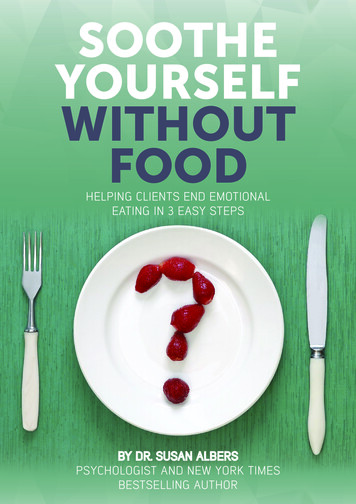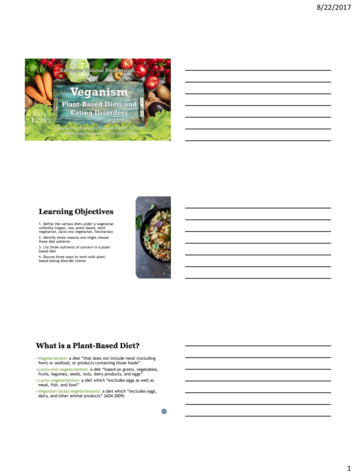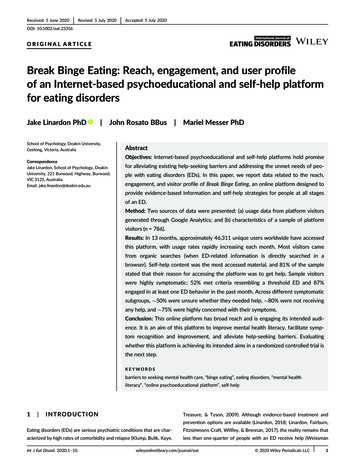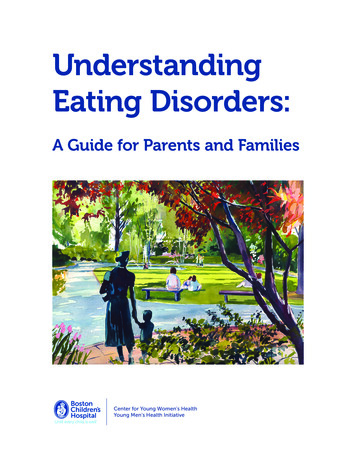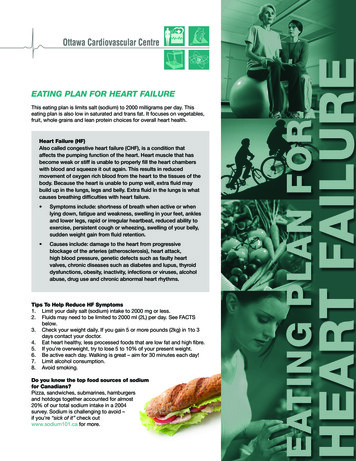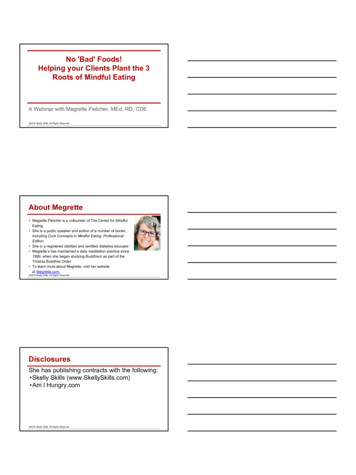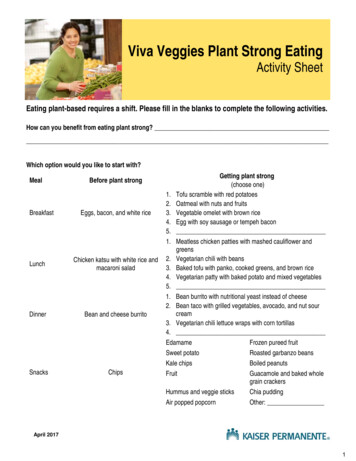
Transcription
Viva Veggies Plant Strong EatingActivity SheetEating plant-based requires a shift. Please fill in the blanks to complete the following activities.How can you benefit from eating plant strong?Which option would you like to start with?MealBreakfastBefore plant strongEggs, bacon, and white riceLunchChicken katsu with white rice andmacaroni saladDinnerBean and cheese burritoSnacksChipsGetting plant strong(choose one)1. Tofu scramble with red potatoes2. Oatmeal with nuts and fruits3. Vegetable omelet with brown rice4. Egg with soy sausage or tempeh bacon5.1. Meatless chicken patties with mashed cauliflower andgreens2. Vegetarian chili with beans3. Baked tofu with panko, cooked greens, and brown rice4. Vegetarian patty with baked potato and mixed vegetables5.1. Bean burrito with nutritional yeast instead of cheese2. Bean taco with grilled vegetables, avocado, and nut sourcream3. Vegetarian chili lettuce wraps with corn tortillas4.EdamameFrozen pureed fruitSweet potatoRoasted garbanzo beansKale chipsBoiled peanutsFruitGuacamole and baked wholegrain crackersHummus and veggie sticksChia puddingAir popped popcornOther:April 20171
Starting to get plant strong On a scale from 1 to 10, how ready are you to make a change to plant-based eating? (1 not ready, 10 totally ready)12345678910 I am ready to make a lifestyle change. Over the next week, I will:What:How often:How much/many:Examples of goals Cut meat back to 2 times a week at Replace all animal protein with plantdinner and add beans and vegetablesprotein Switch to dairy free milk Limit processed foods to twice a week Prepare a plant based meal 3 times a weekOn your ownWrite down what you currently eat at each meal and the change(s) you will make to shift to plant-based eatingMealBefore plant strongGetting plant strongBreakfastLunchDinnerSnackskp.org2
HEALTH EDUCATIONPlant-Based NutritionFrequently Asked Questions & ConcernsNutrition InformationWhat is a plant-based diet?A plant-based diet means that the majority of food a person eats comes from plants and containslittle or no meat, poultry, or seafood. Some people include eggs and dairy products in their plantbased meals, while others do not. Eating meatless meals more often is the basis of a plant-baseddiet. Vegans are total vegetarians who eat no animal products at all.What are the health benefits of a plant-based diet?Research studies have shown that people who eat only plant-based diets are at lower risk for heartdisease, certain cancers, and other health problems such as obesity, diabetes, and high bloodpressure. Compared to the more typical Western diet, plant-based diets are lower in saturated fatand cholesterol, and higher in “good” fats and fiber, all of which support better health.Can I get all necessary nutrients eating a plant-based diet?Common concerns with plant-based diets are that they do not provide enough protein, iron,calcium, vitamin D and vitamin B12. But you can address these nutrient concerns by includingcertain foods in your diet: It is easy to get adequate protein with a plant-based diet as long as the diet includesbeans, lentils, nuts, seeds, grains, and vegetables. Most Americans (USA) consume morethan enough protein, so decreasing protein-rich foods is usually not a concern. Iron is found in nuts, seeds, legumes, potatoes, green peas, quinoa, and fortifiedbreakfast cereals. Adding vitamin C-rich foods to meals (such as citrus, mango, tomatoes,greens, or peppers) improves iron absorption from plant foods. Calcium can be found in dark green leafy vegetables, nuts, and seeds. However, becausethe compounds found in some plant foods can make it harder for your body to absorb thecalcium, it is important to consume a wide variety of calcium-rich plant foods and calciumfortified products, such as fortified soy and almond milk. We get vitamin D from two sources: food and sunlight exposure. Fatty fish and egg yolks arecommon foods with natural vitamin D. Because so few foods contain natural vitamin D,cow’s milk has been fortified with this vitamin for years. If you do not drink cow’s milk, youcan meet some of your vitamin D needs by incorporating fortified soy, rice or almond milkand fortified juices and cereals into your diet. Vitamin D is also produced in the bodythrough exposure to sunlight. Factors that limit the body’s ability to make enough vitamin Dfrom the sun include sunscreen use, clothing, darker skin pigmentation, pollution, aging, andextra body fat. As a result, for most people, adding a vitamin D supplement is a good idea. People who eat no animal products at all must supplement their diets with vitamin B12 orfortified food products such as microalgae, seaweeds and nutritional brewers’ yeast (suchas RED STAR brand), as plants do not provide active B12. You can also check theingredient labels on foods to determine if the foods contain B12. 2012, The Permanente Medical Group, Inc. All rights reserved. Regional Health Education.E-Handout 1082-E Revised 12-12 RL 8.33
HEALTH EDUCATIONFor more information on getting the necessary nutrients or on supplementation needs with a plantbased diet, check with your doctor or a Registered Dietitian (RD). More information is alsoavailable in Kaiser’s Vegetarian Meal Planning handout.If I do not like a lot of plant choices, how can I be sure that I am gettinga well-balanced diet?A nutritionally balanced plant-based diet needs to include fruits, vegetables, whole grains, and plantproteins (legumes, beans, nuts), so eating well on this diet can be a challenge if you dislike many ofthese foods. Make the transition to a plant-based diet gradually so you will be sure you can eat wellwith few or no animal-based foods. Start by finding a couple of vegetables you like andexperimenting with tasty ways of cooking them. Gradually advance to trying one new vegetable aweek. Also try buying food in season. Be open to trying new fruits and vegetables.What can I use in place of dairy milk and yogurt?Try using calcium-fortified soy, rice, and/or almond milk and soy or coconut yogurt in place ofdairy. Of the non-dairy options, soy milk and yogurt provide the most protein and essential aminoacids. All of these options are now available in most grocery stores.I have type 2 diabetes. Can I still get a good balance of protein and carbohydrates on aplant-based diet?Yes. Try the plate method, by filling half of your plate with non-starchy vegetables (salad, greens),/4 of your plate with a whole grain or starchy vegetable (potatoes, corn, brown rice, whole wheatpasta, other whole grains), and 1/4 of your plate with high-protein grains or beans (beans, tofu, peas,lentils, quinoa, edamame), along with a small piece of fruit. For more information on diabetes,carbohydrates, and plant-based diets, contact your local Kaiser Permanente medical facility to speakto a Registered Dietitian.1Meal-PlanningI have a busy schedule. How do I transition to a plant-based diet?Cook extra portions and eat leftovers on busy days. You can also freeze smaller portions of beans,soups, or other main courses, then reheat and add fresh fruit or a salad to make it a meal. Using acrockpot can also help you prepare food, as you can make one-pot meals or cook beans while atwork or while sleeping.You can also start by modifying your favorite recipes before branching out to unfamiliar foods. Trymaking spinach lasagna rather than meat lasagna, veggie pizza, bean chili and cornbread, or yourfavorite soup recipe with beans, diced firm tofu or edamame in place of chicken or meat. See the“Additional Resources” below for cookbooks and online help.What if I don’t like to cook?Try cooking whole grains in advance (brown rice, wheat berries, steel-cut oats) and store them in therefrigerator for use over the next 3 to 4 days, or freeze for later use. Use canned instead of driedbeans. Try a salad-in-a-bag with prepared dressing. Gradually build your cooking skills. Practice witheasy recipes. 2012, The Permanente Medical Group, Inc. All rights reserved. Regional Health Education.E-Handout 1082-E Revised 12-12 RL 8.34
HEALTH EDUCATIONHow often do I need to shop to avoid food spoilage?Do your grocery shopping weekly. Always have staples (beans, rice, quinoa, dried fruit, nuts andseeds), then buy seasonal fruit and veggies. Eat the fresh leafy greens first, and if you run out, thengo to frozen fruit and veggies. A great tip is to blanch fibrous vegetables (such as broccoli,cauliflower and asparagus – not more delicate vegetables like spinach) when you get home from thestore. To blanch, bring a pot of water to a boil, turn off heat, put fibrous vegetables into the waterfor 2 to 3 minutes, and then cool them with ice water. This will make the vegetable bright in color,smaller in size and last twice as long in the refrigerator.Additional QuestionsHow can I tackle food cravings for salt, meat, cheese, sugar, pastries, butter, etc.?Eat regularly. Try eating 3 meals and 2 to 3 snacks daily. This helps to curb the appetite and canbeat food cravings. Many food cravings also disappear when processed food is eliminated or cutdown from the diet. Removing processed food and adding more nutritious choices is important.The body may not be craving more food or calories; it may actually be craving nutrients. A plantbased diet can fulfill your body’s nutrient requirements.But I love cheese! How can I give it up?You are not alone. A lot of people love cheese. Start by using less and getting accustomed to cheeseas a flavor enhancer, not a main source of protein or meat replacement. There are some very tastysoy or other plant-based cheeses available now, but they are more expensive. You can make cashewor nutritional yeast "cheese" as a replacement.How much does following a plant-based diet cost?A plant-based diet can be very affordable. Grains, beans, nuts and seeds can be purchased in bulkin many grocery stores, and are generally less expensive than meats. Buying fruits and vegetablesin season or frozen can save you money. Most dried seasonings, herbs and spices have a longshelf life.I have meals delivered. How can I incorporate plant-based choices into these meals?Most meal delivery services have vegetarian choices. Many of them will have cheese as a prominentingredient in the main dish. Save half of these dishes for another meal or share with a friend. Thenbalance the rest of that meal with other vegetables and fruits.What do I do if my family supports my change, but is not ready to change theireating habits?Ask if they are willing to try eating plant-based for one month, or suggest that they try a new plantbased main course once a week. Introduce new foods along with familiar foods you know they love.For example, serve grilled portobello mushroom burgers with sliced avocado in place of acheeseburger. You may not get your family to completely adopt your new eating style, butremember that every person is on their own personal journey. Check out the ‘Additional Resources’for information on local support groups and websites. 2012, The Permanente Medical Group, Inc. All rights reserved. Regional Health Education.E-Handout 1082-E Revised 12-12 RL 8.35
HEALTH EDUCATIONAdditional resources Contact your Kaiser Permanente Health Education Center or Department for healthInformation, programs, and other resources. For personalized vegetarian meal planning ask your doctor for a nutrition referral witha Registered Dietitian. Make an appointment with a Wellness Coach to talk about healthy choices you’d liketo make.Online Vegetarian Meal Planning, Kaiser r/pdf/6151.pdf 21daykickstart.org for help transitioning to a plant-based diet compassionatelivingoutreach.org or meetup.com to find out about local vegansupport groups nutritionmd.com for help adopting a healthy diet and meal planning ideas veggiequeen.com for pressure cooker information, cooking videos, and recipes cancerproject.org and happyherbivore.com for more recipe ideasBooks Prevent and Reverse Heart Disease by Caldwell B. Esselstyn, Jr., MDThe Engine 2 Diet by Rip EsselstynThe China Study by T. Colin CampbellThe New Becoming Vegetarian: The Essential Guide to a Healthy Vegetarian Diet, The NewBecoming Vegan, and The Complete Guide to Adopting a Healthy Plant-Based Diet by Melina& Davis Vegetarian Cooking for Everyone by Deborah Madison The Complete Idiot’s Guide to Plant-based Nutrition by Julieanna Hever, MS, RD, CPTThis information is not intended to diagnose health problems or to take the place ofmedical advice or care you receive from your physician or other health care professional.If you have persistent health problems, or if you have additional questions, pleaseconsult with your doctor. 2012, The Permanente Medical Group, Inc. All rights reserved. Regional Health Education.E-Handout 1082-E Revised 12-12 RL 8.36
THE PLANT-BASED HEALTHY PLATEFill one-quarterof your plate witha plant-basedprotein source,such as cookedbeans, lentils, ortofu.Fill half ofyour platewith nonstarchy vegetables such ascarrots, broccoli, Chinesecabbage, eggplant, greens,spinach, long beans,marungay, mushrooms, luauleaves, peppers, tomatoes,seaweed, or zucchini.Use this plate to help you portion yourfood in a healthy way and make mealplanning easier. Portions are based ona small dinner plate.Fill one-quarter of yourplate with whole grainsor starchy vegetablessuch as barley, brownrice, corn, poi, taro(kalo), breadfruit (ulu), quinoa,whole-wheat pasta, sweetpotatoes, pumpkin, whole grainbread, or corn tortillas.For good nutrition alsochoose each day: 2-3 servings of fruit. A servingis a small orange, banana, orapple ½ medium papaya, ½ cuppineapple or 1 cup of berries,or melon 2 to 3 cups of a milksubstitute, such as almond,hemp, oat, or soy A small amount of healthyfats, such as avocado, extravirgin olive or canola oil7
These sample meals and snacks include foods from the shopping list below andfollow the tips on the other side. Create your favorite combinations! Portions varyfrom person to person and can be adjusted based on your needs.Ideas for mealsand snacksLunch and DinnerBreakfast 2 slices sprouted grain or 1 small 1/4 cup scrambled soft tofu and 1whole wheat bagel with nutcup spinachbutter or cashew cheese 1 sprouted-grain English muffin 1 cup diced melonor 2 corn tortillas 1/4 avocado 1/2 cup mango 2 slices sprouted grain orwheat toast and 2 tbsp. “natural”nut butter 1 cup nondairy milk ½ medium papaya1 cup whole-grain cereal1/2 banana, 1/2 cup berries10 walnuts1 tbsp. ground flaxseed1 cup nondairy free milk 1 tbsp. ground flaxseed 2 slices sprouted grainor wheat toast 1 cup berries 1 cup nondairy milk 1 cup oatmeal with 1 tbsp.pumpkin seeds and 2 tbsp.raisins 1 cup nondairy milk 1 cup chia pudding and 1/2 cupdiced fruit ¼ cup nuts2 /3cup brown ricecup beans1 cup cooked vegetables1/2 cup salsa1/2 cup avocadoAdd 1 cup nondairy milk to each meal (optional) 4 oz. baked tofu sandwich onsprouted-grain or wheat breadwith 1–2 tbsp. avocado, lettuceor spinach, tomato, and onion Carrots or broccoli 1 orange 2 cups stir-fried vegetableswith tofu or tempeh (sautéedwith 1 tsp. olive oil and garlic) 1 cup quinoa, yam, or whole-grainpasta 1 cup tofu poke with lomi tomato,onions, and fern shoots (ho’i’o orwarabi) 1 -1 ½ cup poi or kalo or ulu guava 1½ cups vegetarian chili or 3 beansalad 2 tbsp. pumpkin seeds or avocado 1 cup cabbage slaw with lime juice 1/3 cantaloupe 3–4 oz. veggie (bean, lentil,soy) burger on sprouted-grainor wheat bun Garden salad with avocadoand 1–2 tbsp. oil and vinegardressing Diced peaches or pearChinese cuisine 1/2 -1 cup brown rice or quinoa 1 cup-2 cups broccoli tofu(sautéed in broth) 1 cup vegetarian hot-andsour soupWatercress tofu salad Watercress, cubed tofu, dicedtomatoes, sliced sweet onions,shoyu, and sesame sauce Lychee PineappleIndian cuisine 1 cup lentil soup (dal) or chickpeas(Chana Masala) 1 whole-grain flatbread or basmatirice 1 cup medley of vegetableswith garam masala1 /2Snacks 1/2 cup baked sweet potato (uala) Raw vegetables with hummus 2 tbsp. dried fruit or nuts 1½ oz. cashew cheese Fresh fruit Medium apple with 1–2 tbsp.“natural” peanut butter 3 cups air-popped or lightmicrowave popcorn Rye crackers with 1½ oz. cashewor nut cheese ½ cup roasted garbanzo beans Fresh non-starchy vegetablesMexican cuisine 2 bean tacos made with 2 corntortillas, 1 cup whole beans, 2 Luau leaves with uala, carrots,tbsp. avocado, salsa, shreddedshitake mushroom, gobo, or ululettuce or cabbage, and tomatoes Grapes Diced mangoVegetable Lau Lau or LuauHealthy meals start at the store. Use this shopping list to help you prepare. Fruits—fresh, frozen, canned in theirown juice, or dried Vegetables—fresh, frozen, or lowsodium canned Kimchee, sauerkraut, or otherpickled vegetables Nondairy, unsweetened milk (fortifiedhemp, soy, oat, or almond) Unsweetened nondairy yogurt (soy or almond) “Natural” peanut or another nutbutter Whole beans (dried or low sodiumcanned), or lentils Hummus or bean spreads Tofu (silken, firm), tempeh, or natto Avocado, olives, or sun-dried tomatoes Whole grains and starchy vegetables— in addition to those listed on frontpage include oats, whole wheat tortillas(no hydrogenated oils), orange coloredsquash, corn, mixed vegetables, andpopcorn (air popped) Fats and oils, such as extra virginolive, or avocado oils, nuts andnut butter, seeds (e.g. chia, flax,hemp, pumpkin, sesame,sunflower, or tahini) Frozen vegetarian entrées or veganburritos and soups (keep some onhand for a quick meal) Seasonings — light soy sauce,tamari, vegetable broth, or Bragg’sliquid amino nutritional yeast Spices — assorted Vinegars — balsamic or riceThis information is not intended to diagnose health problems or to take the place of medical advice or care you receive from your physician or other medicalprofessional. If you have persistent health problems, or if you have additional questions, please consult with your doctor. 2011, TPMG, Inc. All rights reserved. Regional Health Education. Reproduced with permission from copyrighted material of the SCPMG Center for Healthy Living.011061-438 (Revised 04/13/2020) RL 8.68
Easy to prepare plant-based mealsRound your meal with a tossed salad, fruit and/or glass or dairy-free milkHummus spread on whole wheat tortilla with greens, cucumber and tomato slicesLentil soupQuinoa with roasted vegetables, sunflower seeds and whole wheat pitaTofu poke and poi or brown riceBaked potato topped with vegetarian chiliVegetarian nishime with gobo saladMiso soup with tofuVegetarian bi bim bap with tofuVegetable and tofu phoVegetarian laulau and lomi tomato saladSweet potato and vegetarian sausage hashBlack bean burrito with salsa and guacamoleGrilled or pan fried tofu brushed with sesame oil, brown rice and grilled vegetable medleyBell pepper or eggplant stuffed with quinoa, cashews and vegetablesGrilled portabella mushroom sandwichThai noodles with vegetables and peanut sauceEdamame and natto hand-roll sushiSeasoned tempeh stir fried with vegetablesTop a tossed salad with garbanzo, kidney or soybeans and top with diced apples, beets,and sliced olives9
Mung Bean Tofu Papaya Soup1 – 2 Tbsp. Canola Oil(Serves 6 to 8)11/2 Tbsp.Bragg Liquid Aminos orfish sauce (Patis)1Onion, julienned2 Tbsp.2 Tbsp.Garlic, mincedGinger, minced. Plus one2 CupsGreen papaya, cut in 1/2” cubes1Block of tofu*, med. or firm, cubedpiece smashed4 Cups Fresh spinach or leafyDried mung beans, rinsedVegetarian or low-sodiumgreens Black pepper to taste/23/4 Cup6 Cupschicken broth or water1/4 CupSliceddriedshiitake*1 pound of chicken, skinned and cut in bitesize pieces, can be used instead of, or withtofu. If using chicken, stir fry with onion.mushrooms (soaked in water forPlace canola oil in a large pot on medium-high heat and let heat for 1 minute.Add onion and stir fry for 1-2 minutes then add garlic and ginger and saute for another 1 minute. Addmung beans, broth, mushrooms, and Bragg Liquid Aminos. Bring up to a boil, then let simmer for about40 minutes or until beans are tender, skimming off any froth on the top.Add green papaya and tofu and simmer for an additional 10 minutes or until papaya is forktender.Add spinach and let wilt, should take less than a minute.Taste to ensure seasoning, then serve!Tips to reduce gasRinse dried beans well in cold, running water.Soaking beans before cooking helps to remove some of those indigestible sugars that causeflatulence. There are two simple ways to get the job done: Regular soak: Put beans into a large bowl and cover with 2 to 3 inches of cool, clean water. Setaside at room temperature for 8 hours or overnight; or in the fridge if it is very warm. Drain beansafter soaking. Quick soak: Put beans into a large pot and cover with 2 to 3 inches of cool, clean water. Bring to aboil then boil briskly for 2 to 3 minutes. Cover and set aside off of the heat for 1 hour; drain well.Links for plant based and other y10
Stir-Fried Soba Noodles With Shiitakes, Edamame and Bok ChoySERVINGS: 4PREP TIME: 10 MINUTES COOKING TIME: 20 MINUTESINGREDIENTS1/2 CUP CHICKEN OR VEGETABLE STOCK1 TABLESPOON LOW-SODIUM SOY SAUCE (MORE TO TASTE)1 TABLESPOON RICE WINE1/2 TEASPOON SUGARSALT TO TASTE1 TABLESPOON MINCED GARLIC1 TABLESPOON MINCED GINGER1/4 TEASPOON RED PEPPER FLAKES (OPTIONAL)8 OUNCES SOBA NOODLES2 TEASPOONS SESAME OIL1 TABLESPOON OLIVE OIL6 OUNCES SHIITAKE MUSHROOMS, STEMMED, CAPS SLICED1/2 POUND BOK CHOY1/4 CUP FROZEN EDAMAME, SHELLED1 BUNCH SCALLIONS, THINLY SLICED, DARK GREEN PARTSSEPARATEDDIRECTIONSCOMBINE STOCK, SOY SAUCE, RICE WINE, SUGAR AND SALT TO TASTE IN A SMALL BOWL. COMBINE GARLIC, GINGER ANDPEPPER FLAKES (IF USING) IN ANOTHER BOWL.BRING A LARGE SAUCEPAN OF WATER TO A BOIL AND COOK SOBA NOODLES ACCORDING TO PACKAGE INSTRUCTIONS,USUALLY 4 TO 5 MINUTES. ONCE NOODLES ARE AL DENTE, DRAIN, RINSE WITH COLD WATER, THEN TOSS WITH 2 TEASPOONSSESAME OIL IN A LARGE BOWL. SET ASIDE.HEAT A LARGE SAUTÉ PAN OVER HIGH HEAT. SWIRL IN OLIVE OIL AND ADD GARLIC, GINGER AND PEPPER FLAKES. STIR-FRYFOR NO MORE THAN 10 SECONDS, THEN ADD MUSHROOMS. STIR-FRY FOR 1 MINUTE, THEN ADD BOK CHOY, EDAMAME ANDTHE LIGHT PARTS OF THE SCALLIONS. STIR-FRY 2 MINUTES. ADD NOODLES AND THE STOCK MIXTURE. REDUCE HEAT TOMEDIUM AND STIR-FRY 1 TO 2 MINUTES. ADD DARK GREEN PART OF THE SCALLIONS, STIR-FRY ANOTHER MINUTE,UNTIL WELL COMBINED, AND SERVE.11
DIRECTIONSSauté garlic and onion in a little vegetable broth.BUTTERNUT OR OTHER ORANGE SQUASHAND CHICKPEA COCONUT CURRYAdd squash, chickpeas, milk, tomatoes, broth and seasonings togarlic and onions and heat for 20-30 minutes.SERVINGS: 8INGREDIENTS*For fat free version, use cashews or other plant-based milk (no ricemilk) with 1/4 teaspoon of coconut extract.2 1/2 CUPS DICED BUTTERNUT OR OTHER ORANGE SQUASH4 1/2 CUPS COOKED CHICKPEAS1 SMALL ONION, CHOPPED2 CLOVES GARLIC, MINCED1 CAN (13.5 OUNCES) LIGHT COCONUT MILK*1-2 LARGE TOMATOES, DICED3 CUPS LOW-SODIUM VEGETABLE BROTH OR WATER3 TABLESPOONS YELLOW CURRY POWDER1 TEASPOON KOSHER SALT (OPTIONAL)1 BUNCH OF FRESH SPINACH OR KALE, RINSED AND ROUGHLY CHOPPED1 1/2 CUPS GREEN PEAS (FRESH OR FROZEN)1 HANDFUL OF FRESH CILANTRO, ROUGHLY CHOPPED12
Lentil Soup With Sweet Potatoes and KaleSERVINGS: 8INGREDIENTS1 TABLESPOON CANOLA OIL1 MEDIUM ONION, CHOPPED3 CLOVES GARLIC, MINCED1 MEDIUM CARROT, DICED1 CELERY STALK, DICED2 SMALL SWEET POTATOES, PEELED AND CUT INTO 1/2INCH CUBES1 1/2 CUPS BROWN LENTILS7 1/2 CUPS LOW-SODIUM VEGETABLE BROTH2 CUPS WATER1 LARGE DICED TOMATO2 BAY LEAVES1 TEASPOON DRIED THYME2 CUPS CHOPPED FRESH KALESALT AND PEPPER, TO TASTEDIRECTIONSIN A LARGE POT, HEAT THE OIL. ADD THE ONION AND GARLIC.SAUTÉ UNTIL ONION IS TENDER AND GARLIC IS LIGHT BROWN INCOLOR. ADD CARROT, CELERY AND SWEET POTATOES. COOKUNTIL VEGETABLES SOFTEN, ABOUT 5 TO 7 MINUTES.STIR IN THE LENTILS, VEGETABLE BROTH AND WATER. ADD THEDICED TOMATOES, BAY LEAVES AND THYME AND STIR. COOK ONMEDIUM-LOW HEAT FOR 30 TO 40 MINUTES OR UNTIL LENTILSARE COOKED.ADD THE FRESH KALE. SEASON WITH SALT AND PEPPER (IFNEEDED) AND STIR. REMOVE BAY LEAVES AND SERVE WARM.13
Fiber Facts:Why fiber is importantWhy is fiber important?Including fiber in your diet is good foryour health in lots of ways. It can: Reduce the risk of heart diseaseand type 2 diabetes. Lower the risk of several formsof cancer. Improve cholesterol and bloodpressure. Help regulate your digestion. Help you feel fuller, so youmay eat less.What is fiber?Fiber is the part of plant foods that ourbodies can’t digest or absorb. It is foundin fruits, vegetables, beans, peas, lentils,nuts, seeds, and whole grains.There are 2 kinds of dietary fiber:insoluble and soluble. We benefitfrom both.Whole wheat, oatmeal, rye, cornmeal,bulgur, barley, brown rice, and evenpopcorn are all whole grains.A refined grain has been milled, soonly the middle layer (endosperm) is left.Milling removes much of the vitamins.“Enriched” flour has had some of thenutrients added back, but not the fiber.How much fiber do I need?The American Heart Associationrecommends between 25 and 38grams of fiber a day in a well-balanceddiet. Since most people only consumeabout half that amount of fiber, trythese suggestions to increase the fiberin your diet.Adding more fiber to your dietSoluble fiber comes from fruit, somevegetables, oats, beans, peas, lentils, andbarley. When mixed with liquid, itforms a gel, which helps control bloodsugar and reduces cholesterol.Insoluble fiber comes from fruits,grains, and vegetables. It adds bulk andacts like a brush to clean out the colon. Ithelps food pass through the digestive tractmore quickly and prevents constipation.What is a whole grain?A whole grain has all three ofits original parts: The bran (fiber-rich outer layer). The endosperm (middle layer). The germ (inner layer). Whole grainsare rich in nutrients, including fiber. Eat at least 5 servings of fruitsand vegetables every day. Try more recipes with beans, peas,barley, lentils, quinoa, bulgur, orbrown rice. Choose breads, cereals, tortillas, andcrackers that list a whole grain asthe first ingredient on the label. Make at least half of your grainservings whole grains. Add fiber to your diet slowly, over2 to 3 weeks. If you add it too fast,you may feel bloated or have gaspains. Unless your doctor has told you notto, drink 6 to 8 cups of water andother fluids a day to aid digestion. If you eat wheat bran to keepyour bowels moving, start with1 teaspoon per meal. Increase slowlyto 2 to 4 tablespoons a day. If youuse psyllium fiber supplements, besure to follow the directions anddrink enough fluids to remainhydrated. Buy unprocessed foods whenyou can. Food processing oftenremoves fiber.Read food labelsLook for the “dietary fiber” content onfood labels. Good sources of fiber haveat least 10% of the “percent daily value”for fiber. To find whole-grain foods,look for the words whole wheat orwhole grain in the ingredient list.“Multigrain,” “wheat,” and “enrichedflour” do not mean whole grain. If youare eating gluten-free foods, be sure tocheck the label for fiber content.Nutrition FactsServing Size 2/3 cup (55g)Servings Per Container About 8Amount Per ServingCalories 230Calories from Fat 72% Daily Value*Total Fat 8gSaturated Fat 1gTrans Fat 0gCholesterol 0mgSodium 160mgTotal Carbohydrate 37gDietary Fiber 4gSugars 1gProtein 3gVitamin AVitamin CCalciumIron12%5%0%7%12%16%10%8%20%45%* Percent Daily Values are based on a 2,000-calorie diet.Your daily value may be higher or lower depending onyour calorie needs.Calories: 2,00 0 2,500Total FatLess than 65g80gSat FatLess than 20g25gCholesterolLess than 300mg300mgSodiumLess than 2,400mg 2,400mgTotal Carbohydrate300g375gDietary Fiber25g30gPREVENTION AND HEALTH EDUCATION14
Fiber Content of FoodsVegetablesAsparagus, cooked*Avocado*Baked potato with skinBeetsBreadfruit (ulu)Broccoli cookedBrussel sprouts*Cabbage, cookedCarrots, rawCauliflower, cookedChinese mustard greensCorn, cookedEggplant, cooked*Green beans, cookedKabocha pumpkin*Lettuce, RomaineOnions, choppedPeas, cookedPoiSpinach or luau leaves,cookedSweet potato* or taro(kalo)*, cookedTomato, rawTurnips, cookedBeans, Nuts, andSeedsServingSize½ cup½ cup1 medium½ cup½ cup½ cup½ cup½ cup1 medium½ cup½ cup½ cup½ cup½ cup½ cup2 cups½ cup½ cup½ cup½ cupDietaryFiber (g)2g6g4g2g3g3g3g1g2g1g2g2g2g2g2g2g1g4g1g3-4g½ cup4g1 medium½ cup2g2gServingSizeDietaryFiber (g)¼ cup½ cup4g8g½ cup8g2 tbs2 tbs½ cup½ cup¼ cup¼ cup½ cup¼ cup¼ cup¼ cup½ cup6g4g8g7g3g8g10g3g3g3g5gAlmondsBlack beans, cooked*Black, kidney, or pintobeans*Chia seeds*Flaxseed, ground*Lentils, cooked*Lima beans, cooked*Macadamia nutsMungo beans*Navy beans, cooked*PeanutsPecans, choppedPistachiosSoybeans (Edamame)**High in soluble fiber. Source: USDA NationalNutrition Database for Standard Reference.FruitsApple, with peel*Apricots*Asian pear*BananaCantaloupeCherriesFigs, rawGuavaHoneydewMango*NectarineOrange*PapayaPeach, with skinPear, with s, slicedCerealAll bran (varies with brand)Bran flakes (varies with brand)Bulgar, whole wheat, cookedCheeriosFiber OneOats, old fashioned, cooked*Oats, steel cut, cooked*PopcornRaisin branShredded wheatWheat branWheatiesGrainsBarley, cooked*Brown rice, cookedFarro, cookedQuinoa, cookedRice noodlesRye breadWhole wheat breadEnglish muffin, whole grainPasta, whole wheat, cookedServingSize1 medium1 medium1 medium1 medium½ cup10 medium1 medium½ cup½ cup1 medium1 medium1 medium½ cup1 medium1 medium½ cup½ cup½ cup½ cup½ cupDietaryFiber Size½ cup1 cup1 cup1 cup½ cup1 cup1 cup3 cups1 cup1 cup2 tbs1 cupDietaryFiber (g)10-14g7g6.5g4g14g4.5g5.5g3g7g6g3g3gServingSize1 cup1 cup1 cup1 cup1 cup1 slice1 slice½ muffin1 cupDietaryFiber (g)6g4g5g5g2g2g3g3g4gAdditional resourcesVisit
Vegetarian chili with beans 3. Baked tofu with panko, cooked greens, and brown rice 4. Vegetarian patty with baked potato and mixed vegetables 5. _ Dinner Bean and cheese burrito 1. Bean burrito with nutritional yeast instead of cheese 2. Bean taco with grilled vegetables, avocado, and nut sour cream 3. Vegetarian chili lettuce wraps with .

